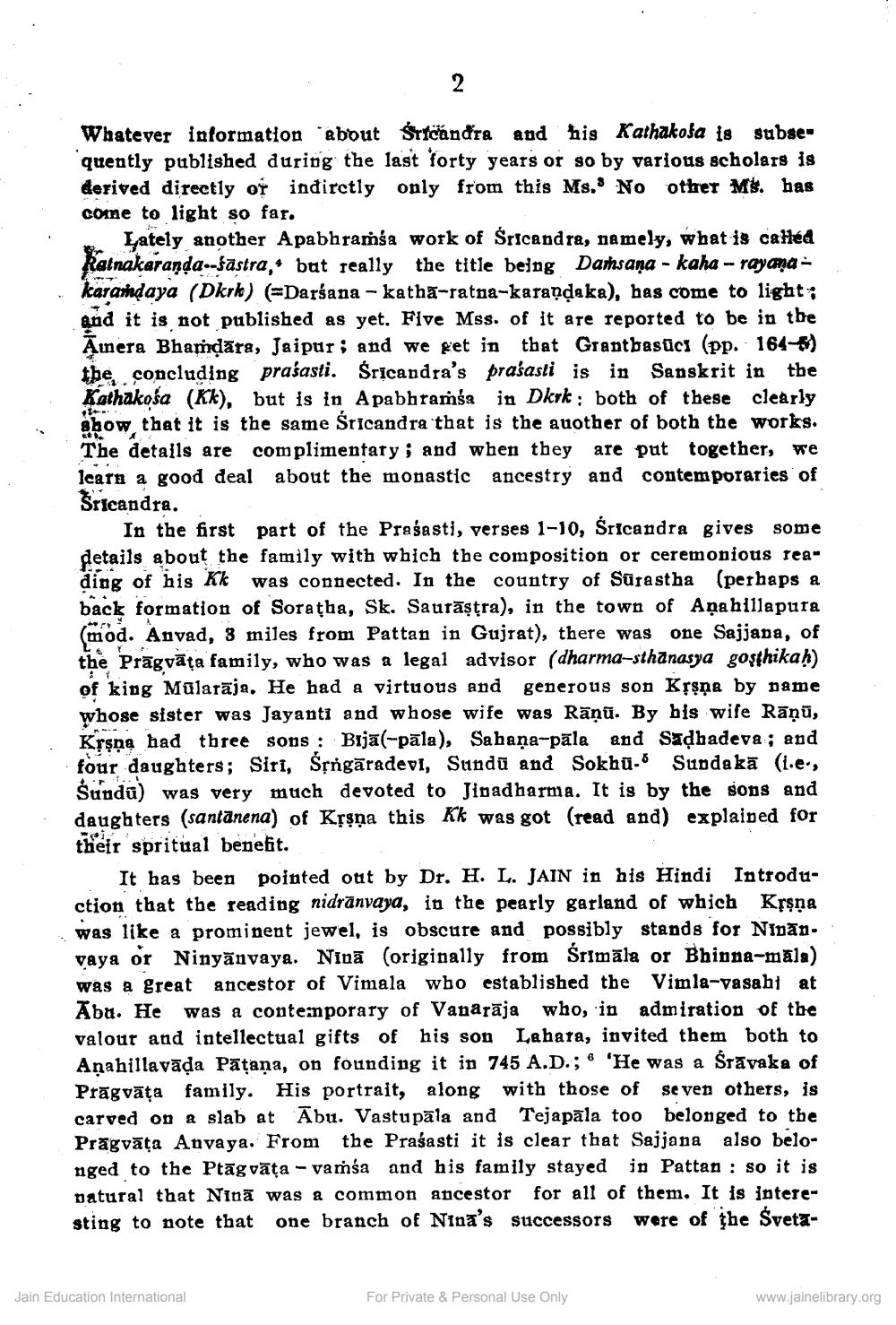Book Title: Kahakosu Author(s): Shreechandmuni Publisher: Prakrit Text Society Ahmedabad View full book textPage 9
________________ Whatever information about Śrtöandra and his Kathakośa is subsequently published during the last forty years or so by various scholars is derived directly or indirctly only from this Ms.' No other M$. has come to light so far. Lately another Apabhramsa work of Śricandra, namely, what is called Ratnakaranda--Sastra * but really the title being Damsana - kaha - rayaa - karamdaya (Dkrk) (=Darśana - kathā-ratna-karandaka), has come to light: and it is not published as yet. Five Mss. of it are reported to be in tbe Āmera Bhamdāra, Jaipur ; and we get in that Grantbasücs (pp. 164-5) the concluding prasasti. Sricandra's prasasti is in Sanskrit in the Kathakośa (KK), but is in Apabhramša in Dkrk ; both of these clearly show that it is the same Śricandra that is the auother of both the works. The details are complimentary; and when they are put together, we learn a good deal about the monastic ancestry and contemporaries of Šrieandra. In the first part of the Prasasti, verses 1-10, Śricandra gives some details about the family with which the composition or ceremonious reading of his Kk was connected. In the country of Sūjastha (perhaps a back formation of Soratha, Sk. Saurāsýra), in the town of Aşahillapura Anvad, 3 miles from Pattan in Gujrat), there was one Sajjada, of rāgvāta family, who was a legal advisor (dharma--sthanasya gosthikah) of king Mularāja. He had a virtuous and generous son Kșşņa by name whose sister was Jayanti and whose wife was Rāņā. By his wife Rāņā, Krsna had three sons : Bijā(-pāla), Sahaņa-pāla and Sadbadeva; and four daughters; Siri, Sțngāradevi, Sundü and Sokhü.6 Sunda kā (i.e., Sundū) was very much devoted to Jipadharma. It is by the sons and daughters (santānena) of Krşņa this Kk was got (read and) explained for their spritual benefit. It has been pointed out by Dr. H. L. JAIN in his Hindi Introduction that the reading nidrānvaya, in the pearly garland of which Krsna was like a prominent jewel, is obscure and possibly stands for Nipān.. vaya or Ninyānvaya. Ninā (originally from Śrmāla or Bhinna-māls) was a great ancestor of Vimala who established the Vimla-vasabtat Āba. He was a contenporary of Vanarāja who, in admiration of the valour and intellectual gifts of his son Lahara, invited them both to Anahillavāļa Pāțaņa, on founding it in 745 A.D.; • 'He was a Śrāvaka of Prāgvāta family. His portrait, along with those of seven others, is carved on a slab at Ābu. Vastupāla and Tejapāla too belonged to the Prăgvāța Anvaya. From the Prasasti it is clear that Sajjana also belonged to the Ptāgvāța - vaņģa and his family stayed in Pattan : so it is patural that Ninā was a common ancestor for all of them. It is interesting to note that one branch of Nina's successors were of the Sveta Jain Education International For Private & Personal Use Only www.jainelibrary.orgPage Navigation
1 ... 7 8 9 10 11 12 13 14 15 16 17 18 19 20 21 22 23 24 25 26 27 28 29 30 31 32 33 34 35 36 37 38 39 40 41 42 43 44 45 46 47 48 49 50 51 52 53 54 55 56 57 58 59 60 61 62 63 64 65 66 67 68 69 70 71 72 73 74 75 76 77 78 79 80 81 82 83 84 85 86 87 88 89 90 91 92 ... 675
